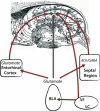Interacting brain systems modulate memory consolidation
- PMID: 22085800
- PMCID: PMC3315607
- DOI: 10.1016/j.neubiorev.2011.11.001
Interacting brain systems modulate memory consolidation
Abstract
Emotional arousal influences the consolidation of long-term memory. This review discusses experimental approaches and relevant findings that provide the foundation for current understanding of coordinated interactions between arousal activated peripheral hormones and the brain processes that modulate memory formation. Rewarding or aversive experiences release the stress hormones epinephrine (adrenalin) and glucocorticoids from the adrenal glands into the bloodstream. The effect of these hormones on memory consolidation depends upon binding of norepinephrine to beta-adrenergic receptors in the basolateral complex of the amygdala (BLA). Much evidence indicates that the stress hormones influence release of norepinephrine in the BLA through peripheral actions on the vagus nerve which stimulates, through polysynaptic connections, cells of the locus coeruleus to release norepinephrine. The BLA influences memory storage by actions on synapses, distributed throughout the brain, that are engaged in sensory and cognitive processing at the time of amygdala activation. The implications of the activation of these stress-activated memory processes are discussed in relation to stress-related memory disorders.
Copyright © 2011 Elsevier Ltd. All rights reserved.
Figures


Similar articles
-
Making lasting memories: remembering the significant.Proc Natl Acad Sci U S A. 2013 Jun 18;110 Suppl 2(Suppl 2):10402-7. doi: 10.1073/pnas.1301209110. Epub 2013 Jun 10. Proc Natl Acad Sci U S A. 2013. PMID: 23754441 Free PMC article.
-
The amygdala modulates the consolidation of memories of emotionally arousing experiences.Annu Rev Neurosci. 2004;27:1-28. doi: 10.1146/annurev.neuro.27.070203.144157. Annu Rev Neurosci. 2004. PMID: 15217324 Review.
-
Role of adrenal stress hormones in forming lasting memories in the brain.Curr Opin Neurobiol. 2002 Apr;12(2):205-10. doi: 10.1016/s0959-4388(02)00306-9. Curr Opin Neurobiol. 2002. PMID: 12015238 Review.
-
Role of the basolateral amygdala in memory consolidation.Prog Neurobiol. 2003 Aug;70(5):409-20. doi: 10.1016/s0301-0082(03)00104-7. Prog Neurobiol. 2003. PMID: 14511699 Review.
-
Adrenal stress hormones, amygdala activation, and memory for emotionally arousing experiences.Prog Brain Res. 2008;167:79-97. doi: 10.1016/S0079-6123(07)67006-X. Prog Brain Res. 2008. PMID: 18037008 Review.
Cited by
-
Time-dependent changes in hippocampal and striatal glycogen long after maze training in male rats.Neurobiol Learn Mem. 2021 Nov;185:107537. doi: 10.1016/j.nlm.2021.107537. Epub 2021 Oct 8. Neurobiol Learn Mem. 2021. PMID: 34634434 Free PMC article.
-
Threat Response System: Parallel Brain Processes in Pain vis-à-vis Fear and Anxiety.Front Psychiatry. 2018 Feb 20;9:29. doi: 10.3389/fpsyt.2018.00029. eCollection 2018. Front Psychiatry. 2018. PMID: 29515465 Free PMC article. Review.
-
Amyloid β oligomers (AβOs) in Alzheimer's disease.J Neural Transm (Vienna). 2018 Feb;125(2):177-191. doi: 10.1007/s00702-017-1820-x. Epub 2017 Dec 1. J Neural Transm (Vienna). 2018. PMID: 29196815 Review.
-
The effect of arousal during and post-training on memory consolidation in detection dogs.Sci Rep. 2025 Jul 16;15(1):25822. doi: 10.1038/s41598-025-09902-2. Sci Rep. 2025. PMID: 40670480 Free PMC article.
-
The Neurobiology of Fear Generalization.Front Behav Neurosci. 2019 Jan 15;12:329. doi: 10.3389/fnbeh.2018.00329. eCollection 2018. Front Behav Neurosci. 2019. PMID: 30697153 Free PMC article. Review.
References
-
- Aerni A, Traber R, Hock C, Roozendaal B, Schelling G, Papassotiropoulos A, Nitsch RM, Schnyder U, de Quervain DJ. Low-dose cortisol for symptoms of posttraumatic stress disorder. Am J Psychiatry. 2004;161:1488–1490. - PubMed
-
- Allchin RE, Batten TF, McWilliam PN, Vaughan PF. Electrical stimulation of the vagus increases extracellular glutamate recovered from the nucleus tractus solitarii of the cat by in vivo microdialysis. Exp Physiol. 1994;79:265–268. - PubMed
Publication types
MeSH terms
Substances
Grants and funding
LinkOut - more resources
Full Text Sources
Other Literature Sources

